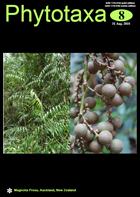Abstract
The size and geographical distribution of the genus Vernonia, tribe Vernonieae, has been greatly reduced as a result of several revisionary studies. All species of Vernonia are now confined to the New World with the vast majority in continental North America. Of the South American species that were not placed in other genera in these treatments, but remained in Vernonia [i.e., V. echioides (Paraguay, Uruguay), V. greggii (Mexico), V. incana (Paraguay, Uruguay), V. perangusta (Brazil), V. rubioides (Brazil)], few have been studied in detail to confirm their generic status. Our work shows that V. perangusta is a member of the genus Vernonanthura and is hereby transferred to that genus. We also studied the widespread and variable taxon known originally as Vernonia polyanthes. This species was transferred to Vernonanthura as V. phosphorica (based on Chrysocoma phosphorica), but the name Eupatorium polyanthes has priority over Chrysocoma phosphorica and thus a new combination for that taxon is also required in Vernonanthura.

